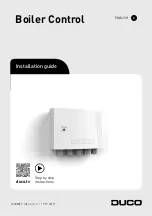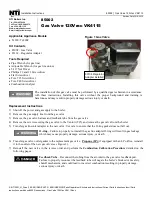
31
. Venting
(continued)
G. Polypropylene Venting
1. Running Flexible Polypropylene Vent (Liner)
Through Unused Chimney Chase
a. It is the responsibility of the installing contractor
to procure polypropylene vent system pipe and
related components.
b. All listed polypropylene vent system
manufacturers must comply with the
requirements of
ULC-S636-08
‘Standard for
Type BH Gas Venting Systems’. For Canadian
installation, polypropylene vent must be listed
as a
ULC-S636
approved system.
c. Flexible polypropylene pipe must be treated
carefully and stored at temperatures higher than
41 degrees F.
d. When flexible polypropylene pipe (liner) is used
for combustion air supply, the pipe (liner) can be
installed in a vertical or horizontal position.
e. Follow manufacturer instructions regarding
application/listing, permits, minimum clearances
to combustibles, and installation details (proper
joint assembly, pipe support and routing,
gasket and fitting installation, optional tooling
availability/usage, routing through masonry
chimney for combustion product venting or,
combination of combustion product venting and
combustion air supply).
f. When using a masonry chimney as a passageway
for flexible polypropylene pipe, the chase must
be structurally sound and free of any debris or
obstructions.
g. To prevent condensate pooling and damage to
vent, offsets (bend) cannot exceed 45˚. Multiple
offsets are allowed in a chase.
2. Pressure drop for flexible polypropylene line is 20
% greater than from rigid pipe. Multiply measured
flexible polypropylene liner length by 1.2 to obtain
equivalent length.
3. Maximum equivalent vent length of flexible
polypropylene liner is 48 ft. (14.6 m).
WARNING
WARNING
Asphyxiation Hazard. Vent systems made by listed
PP vent system manufacturers rely on gaskets for
proper sealing. When this type of vent system is
used, take the following precautions:
Make sure that gasket is in position and undamaged
in the female end of the pipe.
Make sure that both male and female pipes are
free of damage prior to assembly.
Only cut vent pipe as permitted by the vent
manufacturer in accordance with their instructions.
When pipe is cut, the cut end must be square and
carefully deburred prior to assembly.
Use locking band clamps at all vent pipe joints.
Flexible polypropylene vent must be installed only
in an unused chimney. A chimney, either single or
multiple flue type, is considered unused when one
of the flues is being used for any appliance venting,
or When one of the multiple flues is being used for
appliance venting. The flexible vent installation is
not permitted through any of the adjacent flues.
Do not bend or attempt to install flexible pipe if it
has been stored at ambient temperature below 41
F. This will cause material to became brittle and will
lead to cracks, resulting in flue gas leaks.
Do not install flexible polypropylene pipe at an
angle greater than 45 degrees from vertical when
used for combustion product venting. Failure to do
so will result in improper condensate drainage and
possible subsequent vent pipe blockage.
!
NOTICE
NOTICE
Pressure drop for flexible polypropylene line is 20
% greater than from rigid pipe. Multiply measured
flexible polypropylene liner length by 1.2 to obtain
equivalent length.
Maximum equivalent vent length of flexible
polypropylene liner is 48 ft. (14.6 m).
Installation of a polypropylene vent system should
adhere to the vent manufacturer's installation
instructions supplied with the vent system.
Содержание AMP 1000
Страница 13: ...13 IV AMP Component Identification continued Figure 3 Component Identification 26 25 22 18 2 23 27...
Страница 85: ...85 Notes...
Страница 86: ...86 This page is intentionally left blank...
















































